Welcome to Adama's spring 2018 Integrated Disease Management information page. It is time to look beyond chemical solutions and to implement a variety of additional cultural and practical crop management techniques. Growers and agronomists can no longer rely on fungicides alone to protect wheat crops against septoria.
For further information on Precision Crop Protection in the Spring, please visit our hub. Here you can find all disease and weed management information as well as many resources. Subscribe to receive technical updates through-out the season.
With the choice, scope and efficacy of existing septoria fungicides coming under increasing pressure – both in terms of their effectiveness due to increasing resistance, and their availability due to potential regulatory pressures – growers and agronomists can no longer rely on fungicides alone to protect wheat crops against the UK’s most damaging foliar disease. Instead, the professional arable grower must take a wider ranging, integrated approach to crop management and disease prevention.
This concept of Integrated Disease Management (IDM) requires growers to look beyond chemical solutions and to implement a variety of additional cultural and practical crop management techniques to reduce the initial risk of infection, and where infection has already occurred, to minimise its effects.
Put simply, in the context of protecting UK wheat crops from septoria, Integrated Disease Management involves the following:
While most of the winter wheat varieties on the AHDB Recommended List have septoria resistance scores below 6, varieties with ratings of 6+ are becoming more commonplace. The inclusion of these ‘resistant’ varieties in the rotation can reduce disease development and provide a degree of insurance against delayed spray applications. For the most resistant varieties, it may even be possible to revise both the active component and dose rate of applications, thereby protecting ‘at risk’ actives.
Despite the arrival of these improved varieties, fungicide use remains essential. Spray applications must be timed accurately to protect key leaves, so that infections are unable to really take hold. This means using relevent modes of action (stacked and sequenced usage of multi-sites, azole and SDHI chemistries as appropriate) to provide a strong protective effect.
When using a combination of varieties with different levels of disease resistance, spray application timings should be prioritised for the more susceptible varieties: less susceptible varieties such as Siskin, Graham and Moulton will naturally be able to withstand septoria infection for longer, allowing more susceptible varieties, such as Gallant, Cordiale, Reflection and Santiago, to be treated first.
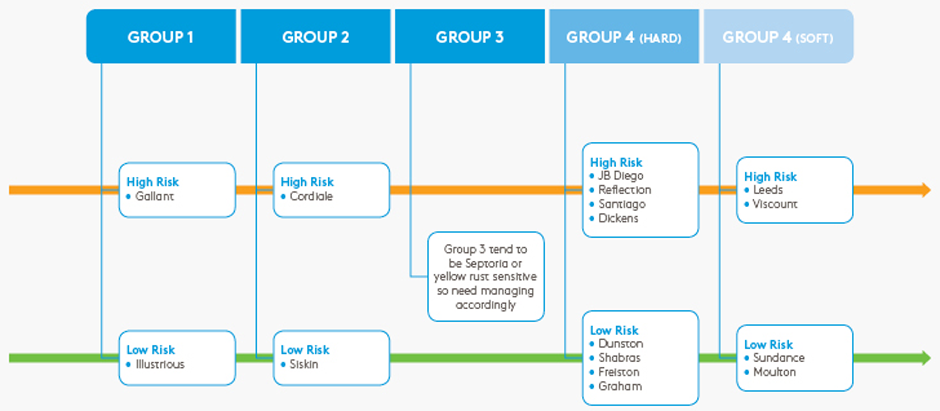
To achieve effective septoria control, growers should adopt the 'prevention is better than cure' mantra. This means looking beyond the can to protect crops, with drilling date and cultural techniques, as well as the use of resistant varieties, all playing an important role.
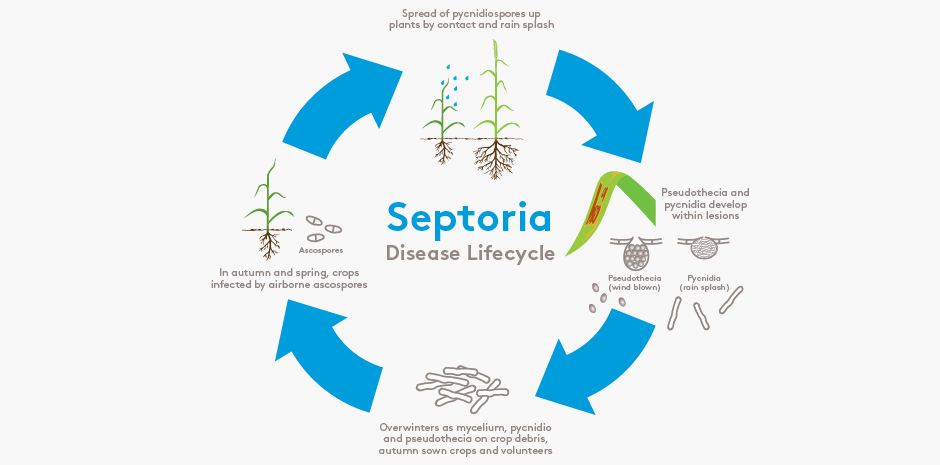
For more information about the septoria lifecycle click on the video below:
The ability to accurately predict when crops are at risk from infection enables growers to extract every drop of performance from the existing fungicide armoury, without further exacerbating the threat of resistance or regulatory pressures.
Knowing when crops are likely to be susceptible to infection also provides growers with an opportunity to provide effective, early protection, thereby avoiding the need for curative activity.
The latest disease forecasting technologies can help to pinpoint the latent period of infection in target leaves: the period between septoria spores infecting the leaf and disease symptoms manifesting themselves. Latent period is measured in day degrees and requires 220 day degrees from initial infection to symptoms showing: if the average daily temperature in late April to mid-May is 10oC, this equates to a 22 day latent period. As temperatures rise, the latent period shortens, with UK latent periods typically ranging from 14 to 28 days.
By considering the weather forecast, infection event status, variety being grown and interval since the last spray, the choice of crop protection product, dose rate and application priority can be tailored to offset the predicted threat of disease.
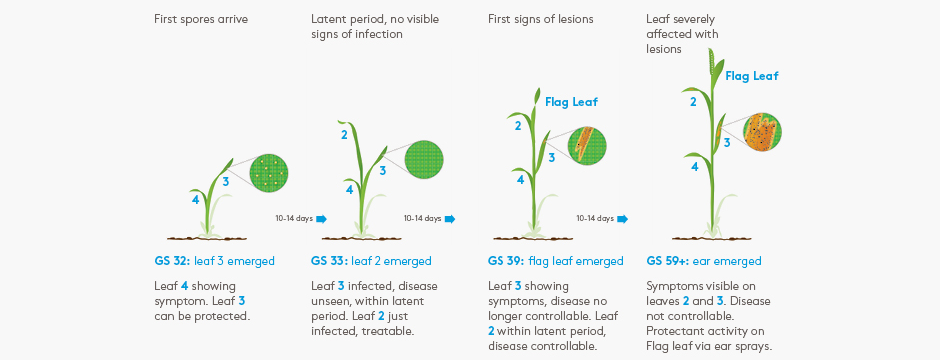
Visible signs of infection may not be apparent until 3-4 weeks after the first septoria spores arrive. Each newly emerged leaf should therefore be protected as soon as the it is fully emerged.
For more information about disease forecasting in arable crops click on the following links:
The septoria fungicide toolbox is limited to three main groups of chemistry: azoles, SDHIs and multi-sites. Although other fungicides such as morpholines can have some effect on the disease, they are not active enough to be used as a key component of a robust septoria strategy. Strobilurins are ineffective against septoria due to widespread resistance, but still have a place in the fight against other diseases.
Azoles:
While azoles such as prothioconazole and epoxiconazole are an important component in septoria control, they are no longer fully effective as curative products: trials have shown that the preventative effect of azoles has reduced by 20% over the last 10 years, while their curative efficacy has fallen by 60% or more.
SDHIs
Or succinate dehydrogenase inhibitors – are highly effective against septoria: they offer strong protectant activity but have limited curative effect. They also offer broad spectrum control of other foliar diseases, but need to be used in moderation in order to protect against the increasing threat of resistance.
Multi-sites
Multi-site fungicides are a vital tool in septoria management: actives such as folpet affect a number of different metabolic sites within a pathogen and are protectant in action. They have no known resistance and remain at a very low risk of resistance.

Despite the advent of less susceptible strains of septoria, and the reduction in efficacy of some fungicides, chemical solutions are still an inherently vital part of the crop protection arsenal. However, for these chemicals to provide effective disease control, they must be used appropriately: failure to use an appropriate fungicide at the correct time, dose or frequency could result in sub-optimal leaf covering, thereby rendering the crop susceptible to infection. Negligent or casual usage of crop protection products also compound the problems associated with fungicide resistance and efficacy in future crops.
Adama’s concept of ‘Precision Crop Protection’ therefore requires the use of appropriate active ingredients in mixture or alternation, applied at the most appropriate time and at the correct dose to provide effective protection. The importance of using good quality crop protection products with proven formulations shouldn’t be underestimated.
Effective septoria prevention requires each new leaf to be protected as early as possible, and certainly during the first half of the disease’s latent period (the period between septoria spores infecting the leaf to disease symptoms manifesting themselves).
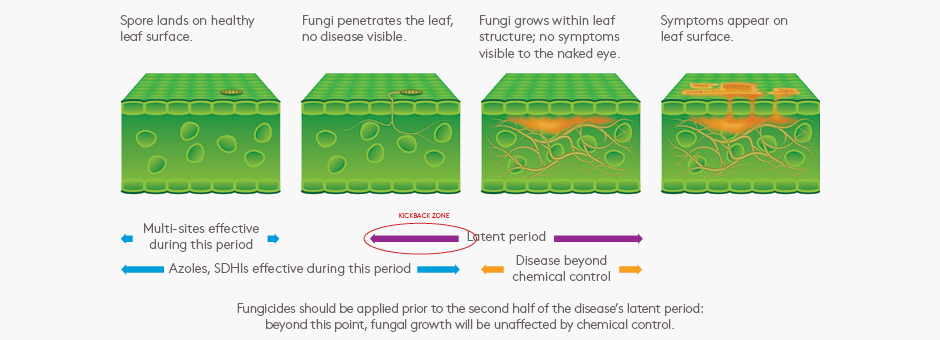
Leaf layering; protecting each new leaf effectively
Because fungicides work better as protective solutions than they do in curative situations, the gap between sprays needs to reflect the crop’s development. For example, if the standard T1-T2 protocol is followed, leaf 2 can be fully emerged and unprotected for 10-14 days before T2 application. This can be longer if the T2 application is delayed, often resulting in leaves becoming infected and in need of a curative solution. Historically, this wasn’t a problem as the fungicide armoury contained azoles which could effectively eradicate existing infection. Unfortunately, the curative efficacy of many of these fungicides is no longer quite so robust, hence the need to avoid entering a situation where curative activity is required.
This situation can be avoided by protecting the newly emerged Leaf 2 at a T1.5 timing – a none routine spray typically reserved for seasons where the T1/T2 gap is stretched due to crop development.
Growers should therefore consider the concept of ‘Leaf Layering’ to ensure optimum leaf coverage and protection during the ‘at risk’ period. Applying a T1.5 application (first choice should be a multi-site to provide contact protection against septoria, potentially mixed with a strobilurin to protect against the threat of rust, or an azole/morpline if active rust is present) will fill the gap between the traditional T1 and T2 applications, and will ensure each new leaf is properly protected from infection, thus providing effective disease prevention and negating the need to rely on curative activity.
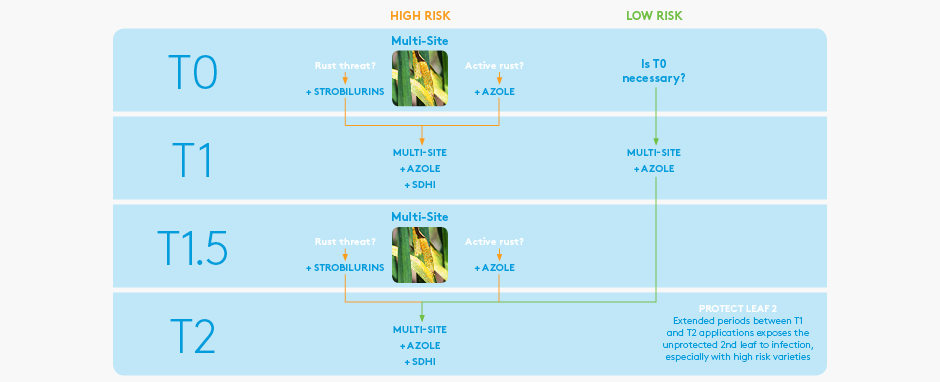
*NB: Please seek advice from a BASIS qualified agronomist to ensure your crop protection programme is fully compliant and appropriate for your crop’s current status.
Growers should also be mindful of the need to use the correct nozzle at each application and to ensure that adequate water volume is used: improving working rates by spraying with lower water volumes than are recommended on the product labels will be counter-productive if the reduced water volume jeopardises leaf coverage.
More information on the correct usage, storage and disposal of plant protection products can be found here: http://www.hse.gov.uk/pesticides/topics/using-pesticides.htm
For more information about correct nozzle selection, click on the link below:
AHDB nozzle selection chart: https://cereals.ahdb.org.uk/media/179976/p05-nozzle-selection-chart-2010-2014-reprint-.pdf
Folpet is an ideal multi-site for use in septoria control, especially where yellow rust is a threat. In addition to providing control of septoria and protecting azoles/SDHIs from the threat of resistance, folpet has activity against rust and, also, does not interfere with the curative kickback activity of partner azoles or SDHIs.
Folpet is available as Arizona(500g/l folpet SC) flexible mixing partner, and Manitoba (50g/l epoxiconazole + 375g/l folpet SC) where it is co-formulated with a leading azole.
In both cases, as with Adama’s wider range of crop protection products, Arizona and Manitoba are based on tried, tested and proven formulations. Unlike other, lesser products, our range has a long proven track record of performance, value and reliability – assets that are at the very core of Adama’s quality and sustainability standards.
For more information about these products go to the following product pages:
Arizona: a unique multi-site protectant fungicide containing straight folpet for providing an anti-resistance strategy for the control of septoria and a range of other cereal diseases in wheat and barley.
Manitoba: a unique combination of the anti-resistance component, folpet, plus a leading azole, epoxiconazole, offering broad spectrum flexible disease control for cereal crops.
Growers and agronomists can no longer rely on fungicides alone to protect wheat crops against septoria. Instead, the professional arable grower must take a wider ranging, integrated approach to crop management and disease prevention. This requires growers to look beyond chemical solutions and to implement a variety of additional cultural and practical crop management techniques to ensure each new leaf is properly protected from infection, thus providing effective disease prevention and negating the need to rely on curative activity.
Third Floor East 1410
Arlington Business Park
Theale
Reading
Berkshire RG7 4SA
United Kingdom
+44 1635 860 555
Email: ukadmin@adama.com
Enquiries: ukenquiries@adama.com